Prague authorities have launched a public awareness campaign to promote the humane treatment of carp, a traditional symbol of Czech Christmas celebrations.
Running until December 23, the campaign highlights carp suffering when handled improperly, such as being kept in bathtubs, killed unprofessionally, or released into rivers.
“We want to emphasize that certain practices surrounding carp handling are extremely cruel and cause immense suffering for these animals,” said Deputy Mayor Jiří Pospíšil (TOP 09) at a press conference.
“This issue has been discussed for many years, and some retailers have already taken steps to address it. The initiative does not aim to ban the sale of live carp in Prague’s streets but seeks to encourage professional and humane practices.”
Why Keeping Carp in Bathtubs is Harmful
Experts warn that keeping live carp in bathtubs causes severe stress and health issues for the fish. “The temperature difference in bathtubs, combined with chlorinated water, creates an environment that is toxic and distressing for carp,” explained Ondřej Slavík, a specialist in fish behavior from the Czech University of Life Sciences. “The fish often exhibit signs of extreme stress, such as poor respiration, necrosis, and erratic swimming.”
Slavík also pointed out that transporting carp in plastic bags poses additional risks, as the fish may suffocate during transit. You can find his study here.
The Myth of River Rescue
Releasing carp into rivers, often seen as a compassionate alternative, can also lead to the fish’s demise. “For carp, rivers are an unfamiliar and hostile environment. Unlike the calm ponds they are bred in, rivers have currents and lack sufficient shelter,” Slavík explained. “This makes them easy prey and significantly reduces their chances of survival.”
Campaign Visibility
To ensure maximum impact, the campaign will appear on digital screens throughout the city, including in public transportation hubs like the Národní třída metro station, medical facilities, and on street furniture. A website provides additional resources and educational materials.
Statistics from the State Veterinary Administration reveal the scale of the issue, with 3,000 carp sales points across the country, 200 of which are in Prague. Around 15% of buyers opt to take live fish home.
Would you like us to write about your business? Find out more
National park Bohemian Switzerland is a great hiking destination. You might have already heard about Pravčická Gate or iconic viewpoints around Jetřichovice.
If you decide to explore more about this hiking paradise, you need quality accommodation. I tried several pensions in this area, but I can recommend only one – Krásná samota. It means “beautiful solitude,” and once you visit this place, you understand why.
Bohemian Switzerland is my favorite place where I like to take my foreign friends for hiking. Our main destination is usually a hiking trek to Pravčická gate, unique stone formation in Europe.
However, I always had an issue finding appropriate accommodation that would allow us to stay for several days and explore the area more. Don’t take me wrong, there are some hotels in Hřensko or pensions in typical Czech cottages, but there was always something that I would not completely recommend it. Until I found Krásná Samota, thanks to Amazing Places recommendation.
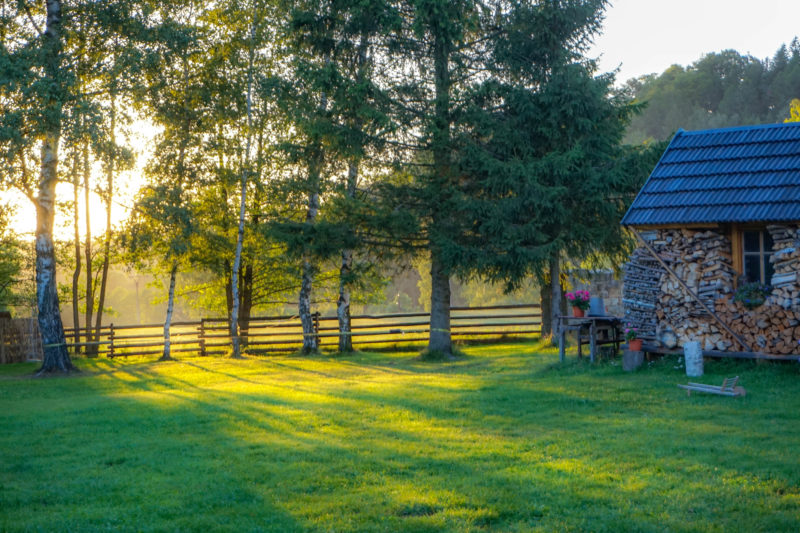
Two hundred years of history
Despite the fact, that pension is really a solitude outside of the civilization, we found it through villages and forests thanks to well-prepared signs. Once we arrived, we were welcomed by friendly dog Lajla and by Marcela with her little daughter Magdalenka. Michal just had a yoga lesson in the attic. Marcela showed us our double room, breakfast area with a fireplace, and a huge garden. It was about sunset time, and I could not help myself and start photographing, it was just magical.
Pension used to be a farmhouse founded in 1818. However, it deteriorated over time, especially during the communist period when private farming was prohibited. In 2013, Michal found this place and started with reconstruction. The whole building is made of natural materials such as wood, sandstone, and clay plasters.
During five years of reconstruction, Michal combined it with his regular job as a hairdresser. Today, he is not pursuing a professional career anymore, and rather enjoys life in the countryside. However, you can still take advantage of his professionalism and have a new haircut.
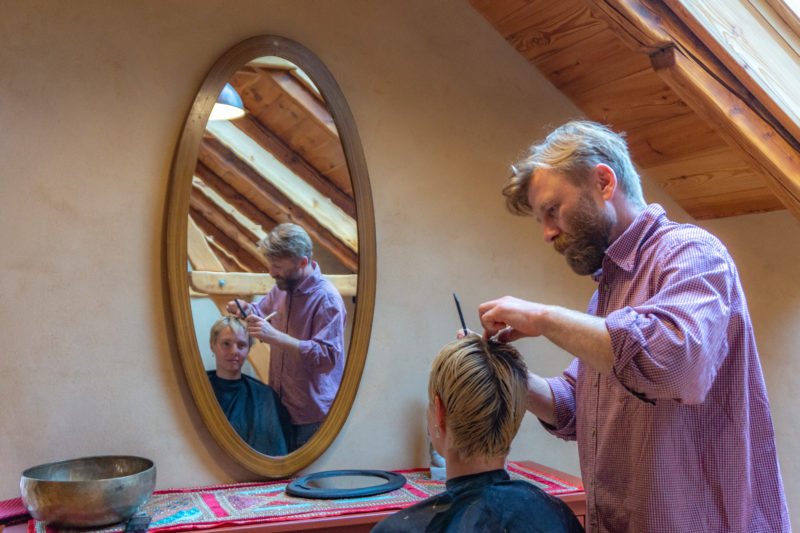
Krásná samota was finally open in 2018 when Michal and Marcela had a one-year-old girl Magdalenka. If you are wondering how they come up with this suitable name, the responsible one is the little one. Although she was not speaking at this time, she brought a book with this name at the moment when her parents were discussing the name. And here it is, the beautiful solitude.
Today, you can find accommodation in one double room or three apartments, each one with a private kitchen and bathroom. You can prepare food by yourself or have a vegetarian breakfast by the fireplace downstairs. The pension can accommodate up to 17 people.
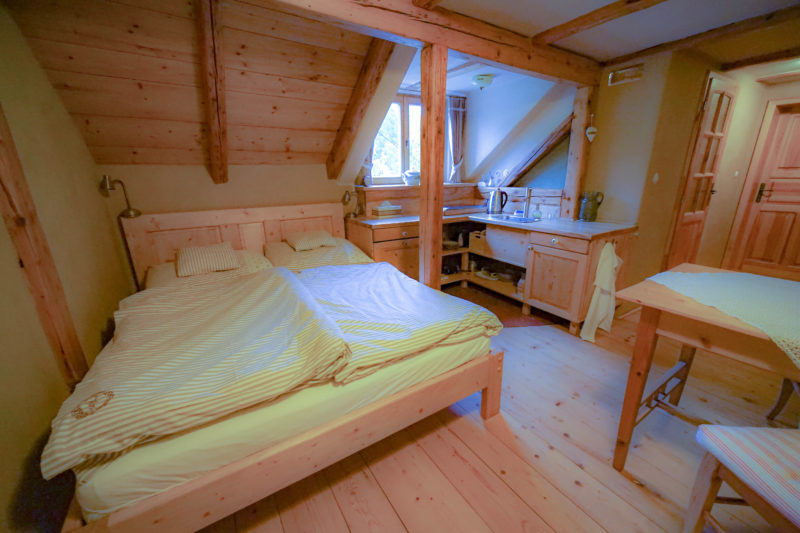
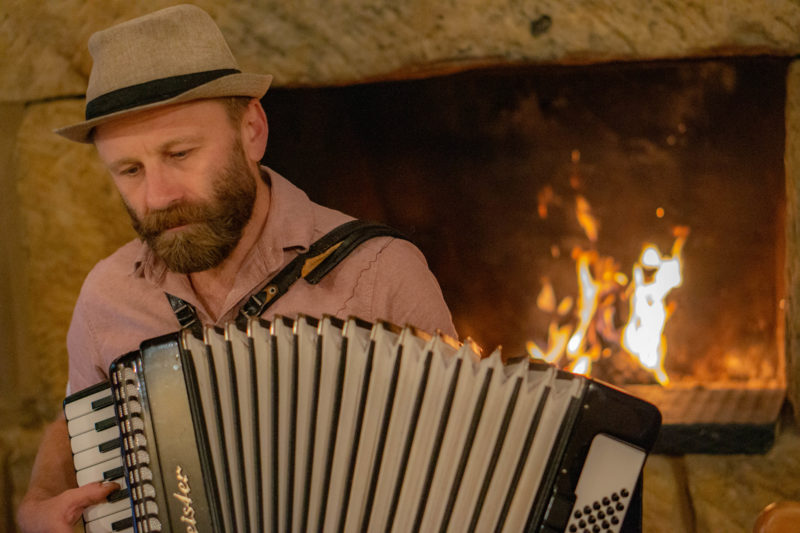
What you can do and see at Krásná samota
The pension itself is a great place for relaxation. You can explore the garden with growing flowers and vegetables, range with sheep and goats, fireplace under the stars, grill place under the shelter or hammock under the trees. In the middle of the garden is a pond with various fishes. Close by; you can even find a beehive thanks to which Michal can provide you, with homemade honey.
During the winter, the garden is still charming, but you can take advantage of the fireplace and choice of local wines, have a yoga lesson with Michal, enjoy the sauna with wellness and massages or relax with your book, anywhere you like.
Therefore, Krásná samota is a great place to relax and active holiday for the whole year. I would highly recommend hiking to Pravčická brána (about 30-minute drive to Hřensko) and hiking to viewpoints around Jetřichovice (about 20 min drive). Pension is a great starting point for bikers and cross-country skiers. If you prefer just a relaxing walk, the nearby village Chřibská is full of charming timbered houses.
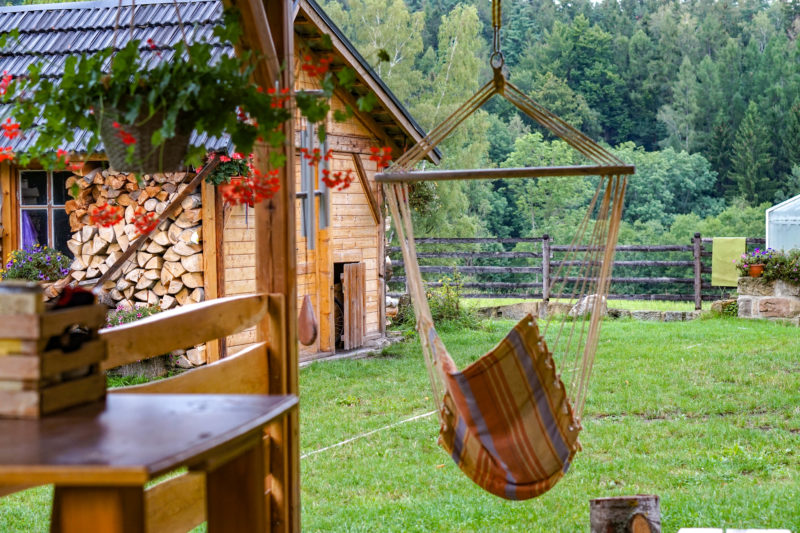
How to get to Krásná Samota
You can drive to Chřibská by highway direction to Dresden and then turn North to Česká Kamenice and village Chřibská. It is about 2 hours drive. In Chřibská, you can find several signs on the way that will take you through the forest to Beautiful Solitude…
Address: Horní Chřibská 84, Chřibská, 407 44
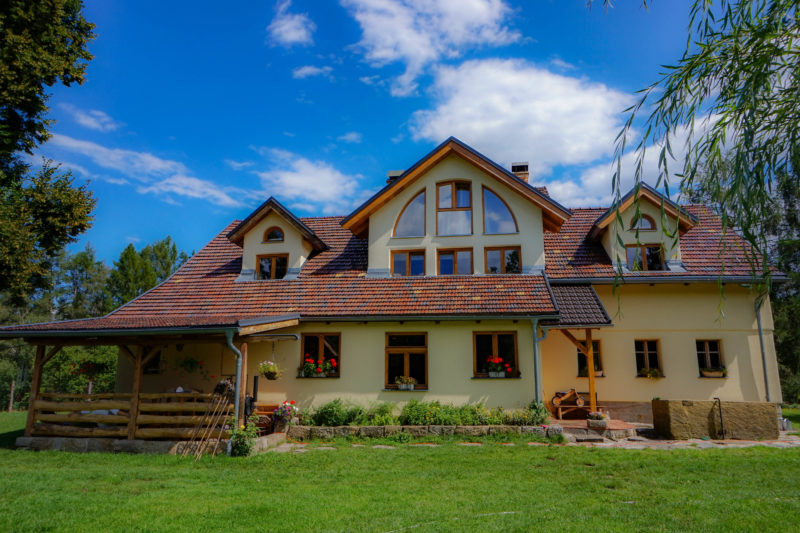
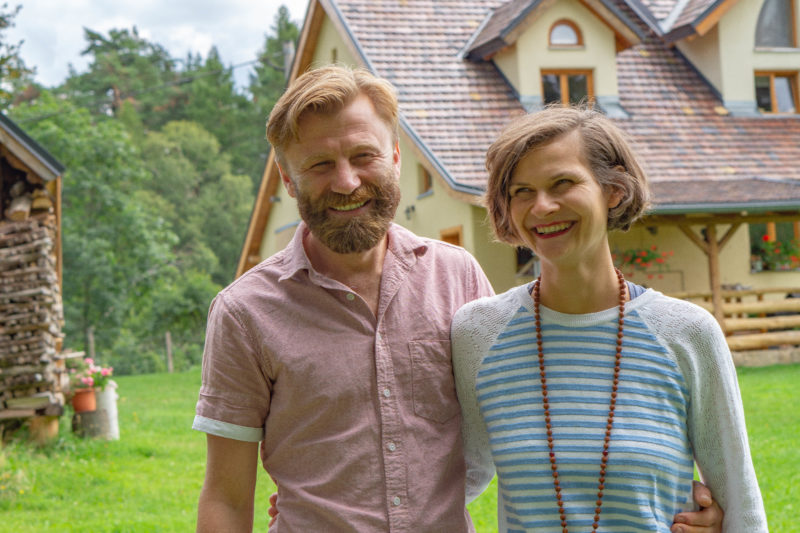
January 16 marks exactly 55 years since Czech student Jan Palach’s self-immolation at the top of Wenceslas Square that would lead to his death in hospital three days later.
Memorial events were held in Prague on Tuesday marking the self-immolation of Jan Palach 55 years ago, on January 16, 1969. Senate speaker Miloš Vystrčil and other senators laid a wreath at a memorial at the top of Wenceslas Square, where Palach, who was 20, set himself on fire in protest at apathy in the face of the Soviet occupation of Czechoslovakia.
About half-past one, Jan Palach doused himself in petrol and set himself on fire near the fountain at the National Museum in Wenceslas Square in Prague. After several minutes, those passing managed to extinguish the living torch.
The seriously burnt student was taken to the Faculty Hospital in Vinohrady, but the injuries were so serious that he had no hope of surviving.
He left a letter at the site explaining the motives of his terrible act: “As our nation is living in a desperate situation, and its reconciliation with fate has reached its utmost stage, we have decided that in this way we will express our protest and shake the conscience of the nation …ˮ He died three days later, on 19 January 1969.
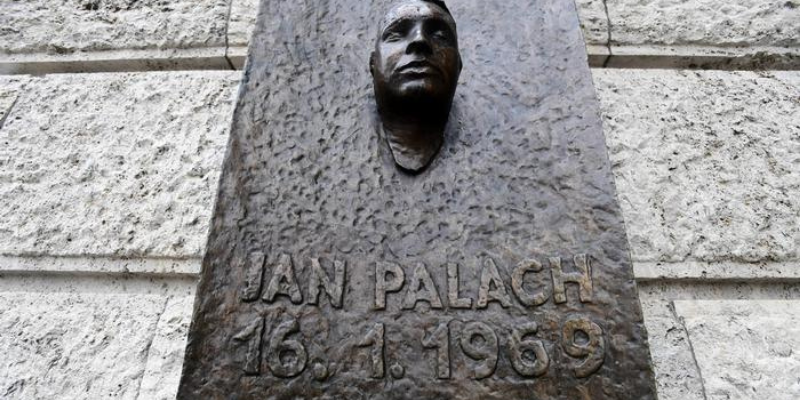
Palach called himself “Torch no. 1” in his letter, giving the impression that he was a part of a larger group which in fact did not exist. But several others followed his example in Czechoslovakia and other eastern bloc countries.
“People must fight against the evil they feel equal to measure up to at that moment,” Palach said before he died in hospital on Jan. 19.
Palach’s death did not change the gradual, almost total resignation in the Czechoslovak Socialist Republic. For almost twenty years, the name Jan Palach could only be whispered in public.
His life story immediately got into “forbidden” songs or strongroom literary works. Only after a change in relations in the autumn of 1989 could historians, documentarists or artists officially and freely present it.
Palach was not the only person to protest via self-immolation. Student Jan Zajíc followed on Feb. 25, 1969, also on Wenceslas Square. In April in the town of Jihlava, Evžen Plocek set himself on fire, though this was less publicized.
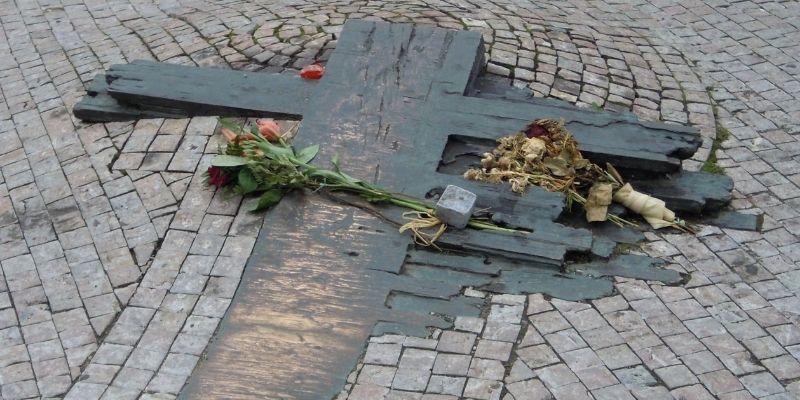
A memorial bronze cross on a small rise in the sidewalk is in front of the National Museum on Wenceslas Square.
There is a square in Prague named after Palach, náměstí Jana Palacha, where the Rudolfinum concert hall; Academy of Arts, Architecture and Design in Prague (VŠUP); Museum of Decorative Arts In Prague (UPM); and Philosophical Faculty of Charles University are located.
There are also streets and places named after him in other Czech towns, as well as in Luxembourg, France, Italy, the Netherlands, Poland, and Bulgaria.
Embers of change
Jan Palach did not die in vain. Two decades later, a group called the Movement of the Children of Bohemia — a self-described “monarchist-anarchist” initiative — took inspiration from his activism and called for new protests.
These activists, like the thousands of others who would prove crucial to putting an end to Soviet rule in Czechslovakia, had been children when Palach set fire to himself in 1969. But on January 15, 1989, they took to Prague’s Wenceslas Square to commemorate his incredible protest and the sacrifice he had made.
They flocked to the square every day for a week, in what later became known as “Palach Week
The entire construction was completed at the beginning of the 15th century.
The foundation stone was laid down by Charles IV on the 9th July 1357 at 5:31 a.m., and the date and time have not been selected randomly.
When we write the numbers down as follows: 1 3 5 7 (year) 9 (day) 7 (month) 5 3 1 (time), we get an increasing and decreasing scale with number 9 at the top:
In addition to this sequence, time was also chosen with respect to the position of the planets – all of the known planets were above the Sunset, which was Lion’s ascendant sign, the Heraldic symbol of the Kingdom of Bohemia. According to the legend, bridge builders added the egg mortar.
Work on the bridge went ahead but Charles IV died long before its completion; in 1378 while the bridge was finished in 1402. In the 17th and 18th centuries, the first of many famous statues were added which came to define the appearance of the famous structure.
From 1883, there was a horse tram passing across the bridge, replaced in 1905 by electrical line. In order to preserve the artistic view of the bridge and not to ruin it with wires leading at the top, Frantisek Křižík came with a special line through the bridge deck.
Yet the heavy carriages vibrated the construction and thus were replaced by buses in 1908. Even the buses were not ideal, so the transport was again stopped the next year, to be renewed in 1932 using buses on tires.
Public transport operated here until World War II, cars stopped driving across the bridge in 1965.
Charles Bridge along with its rich history became one of the most visited, most beautiful, and most valued monuments in Prague.
On World Cleanup Day, 19 September 2020, millions of people in over 150 countries will stand up against global waste pollution by cleaning up communities, parks, forests, and beaches.
Thousands of communities will act together as one, creating a powerful ‘green wave’ of cleanups spanning from New Zealand to Hawaii and lasting for 36 hours.
“During World Cleanup Day last year, nearly 18 million volunteers from 157 countries around the world managed to collect 82,000 tons of waste,” said Miroslav Kubásek, National Coordinator of World Cleanup Day for the Czech Republic.
The aim of World Cleanup Day is not only to pick up waste, but to also raise awareness of the severity of the global climate crisis, drive behaviour change towards less consumption and induce companies, organizations, and governments to adopt more sustainable environmental policies.
World Cleanup Day is organized by Let’s Do It World – a global movement that supports and connects a new generation of community leaders, who are ready to act together to find lasting solutions for the waste problem in their countries.
Taking place on the third Saturday every September, National CleanUp Day was founded to rally volunteers to better our environment by collaborating with one another to improve their local communities.
Any individual, group or organization can start their own cleanup by simply going to the event’s site and signing up.
You can check out the cleanup map and join an event near you. If there is no event organized near you, in your city or neighborhood, take your own initiative and organize a public cleanup yourself.
Ukliďme Česko is a voluntary cleaning event that takes place all over the Czech Republic (and even in a few places outside of it). Its purpose is to clean up illegal black dumps and mess. The event is organized by NGO Ukliďme Česko z. s. in cooperation with other organizations.
- If you are looking for a job in Prague, check our new job section here
- Time to move to a new flat? Rents with no commission here!
- Want to advertise your business on Prague Morning? Contact us at [email protected]
The National Theater in Prague has announced Divadlobraní 2020 campaign. Everyone can purchase tickets with a 40% discount for any performances that will be held from August 10 to September 30.
The promotion applies to performances not only in the National Theater but in its other buildings as well: National Opera, Nová scéna (New Stage), Karlin Musical Theater, Stavovsky Theater.
To get a discount:
– if you buy the tickets at the box office of the National Theater, specify the password “40% Divadlobraní”;
– if you buy the tickets online on the official website, choose the discount “Divadlobraní” from the menu and enter the code “20202021” (without quotes). The system will automatically recalculate the final price.
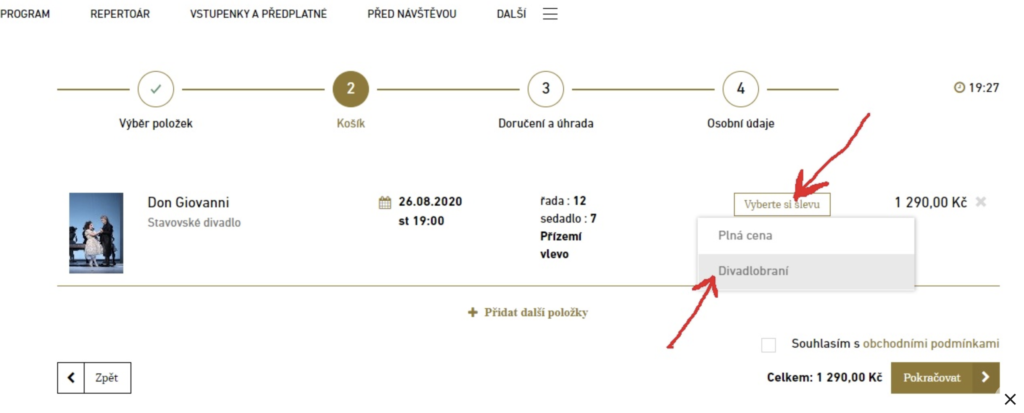
- If you are looking for a job in Prague, check our new job section here
- Time to move to a new flat? Rents with no commission here!
- Want to advertise your business on Prague Morning? Contact us at [email protected]
Three countries have decided to tighten measures for Czech citizens due to the epidemiological situation in the Czech Republic as the daily increase in coronavirus cases in recent weeks is about 200, much more than at the beginning of July.
During Thursday night, Slovenia became the latest country to change the rules for Czechs and, suddenly, put the Czech Republic on the list of medium-risk countries.
Upon entering the country, a two-week quarantine is mandatory for Czech citizens. If they only need to pass through the country, this restriction does not apply to them, but the transit must not exceed 12 hours, the Czech Ministry of Foreign Affairs stated on its website.
On Thursday, Norway also imposed restrictions on the Czechs – they have to spend ten days in quarantine after entering the Scandinavian country. Oslo placed Czechia on the traffic-light system “red” list together with France, Switzerland, and Monaco. Norwegians are also advised to travel to these four countries only when necessary.
Currently, Norway allows free travel to people from countries that have registered less than 20 coronavirus cases per 100,000 population in the last two weeks, which is not the case for the Czech Republic.
This week, Ukraine also decided to include Czechia among countries with an unfavorable epidemiological situation. Thus, upon their arrival in Ukraine, Czechs have to submit a negative coronavirus test or stay in quarantine.
- If you are looking for a job in Prague, check our new job section here
- Time to move to a new flat? Rents with no commission here!
- Want to advertise your business on Prague Morning? Contact us at [email protected]
From Saturday, July 25 at midnight, it will be mandatory to wear face masks at indoor public gatherings with over 100 people, including nightclubs. The Health Minister Adam Vojtěch (ANO) informed Czech Television today afternoon.
“We are not planning to close certain industries or limit the free movement of people, but prevention is needed. The measures taken are based on information from the regional hygienic stations,” said Vojtěch.
“This measure does not concern shops or restaurants, but specifically sports and cultural events,” the minister specified.
A maximum of 500 people seated in five separate sectors, each comprising 100 people, will be allowed at indoor events.
The number of cases is growing, but the risk group over the age of 65 is not affected and there are no more serious cases that require hospitalization. “However, a number of smaller outbreaks show that there may be potential for a community spread,” said the minister.
An outbreak of coronavirus linked to a music club in Prague has recently increased to 98 cases, including footballers from several of the city’s clubs.
PM Babiš stressed that the Czech Republic had managed the first wave of the epidemic very well, but expressed concerns about the daily increase in coronavirus cases.
The number of new cases in the Czech Republic has been growing significantly in recent days. On Tuesday, the country recorded 212 new positive people. On Wednesday, 247.
The number of active coronavirus infections topped 5,000 in the Czech Republic for the first time after labs reported the highest daily rise in nearly a month.
The Czech government will discuss the resumption of the Central Crisis Staff on Monday.
- If you are looking for a job in Prague, check our new job section here
- Time to move to a new flat? Rents with no commission here!
- Want to advertise your business on Prague Morning? Contact us at [email protected]
Comet Neowise might just be the biggest space snowball in decades. After two other promising comets discovered earlier this year — Swan and Atlas — fizzled and faded away, Comet C/2020 F3 (aka Neowise) appears poised to deliver a spectacular show.
On Saturday, NASA published a picture by the Czech photographer Miloslav Druckmüller as an astronomy picture of the day.
NASA’s Astronomical Picture of the Day (APOD) is a prestigious award for the most interesting photographs of the universe, selected and supplemented of caption by astronomers Jerry Bonnell and Robert Nemiroff.
The Comet Neowise was seen above Prague Castle on 13 July 2020.
According to NASA solar system ambassador Eddie Irizarry, it should remain visible just before and around the time of first light until July 11. The comet will then dip below the horizon as it transitions from being an early riser to a cocktail hour sensation, hopefully.
It’ll start to be visible again in the evening around July 15-16. It should be a little easier to see during the second half of July when it’s a little higher in the sky.
The comet’s closest pass by Earth will be July 23, which might make for a particularly exciting viewing opportunity if the comet’s brightness continues to hold where it is or even intensifies. It’ll also rise a little higher in the sky on July 24 and 25 in case you miss the actual flyby date.
Comets are notoriously fickle things that could always break up and burn out at any moment, so fingers crossed.
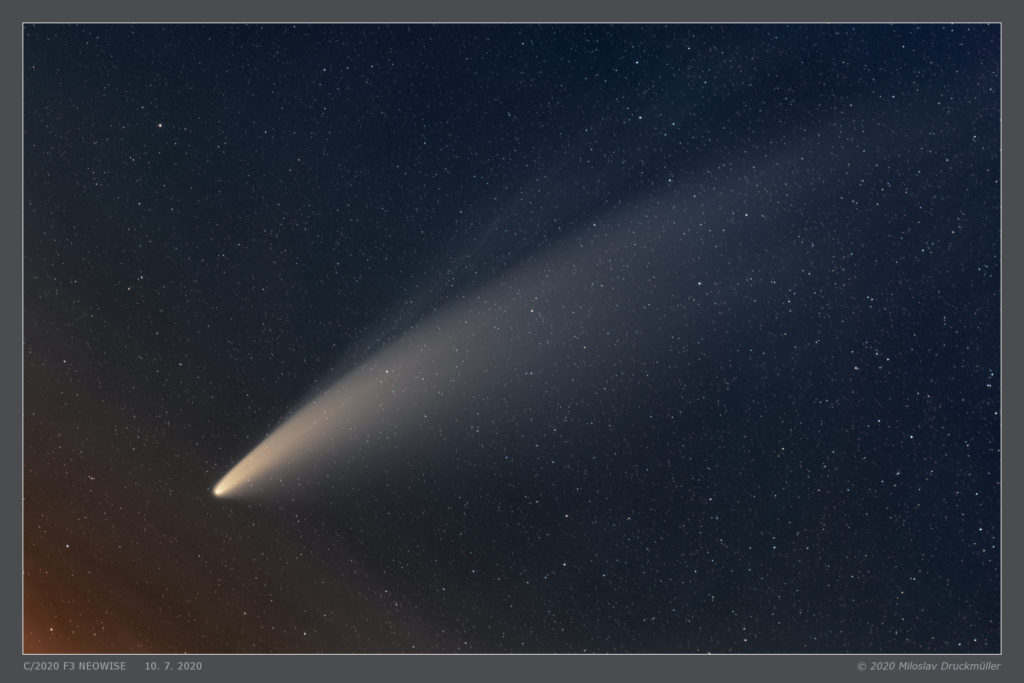
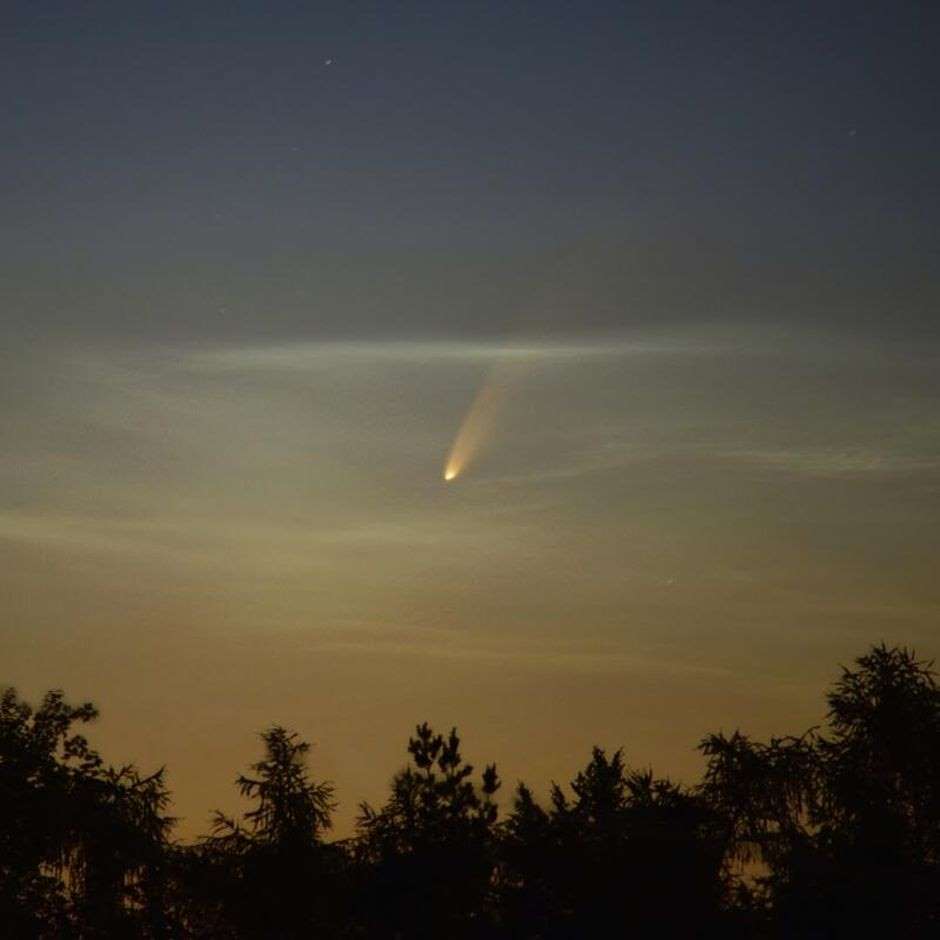
- If you are looking for a job in Prague, check our new job section here
- Time to move to a new flat? Rents with no commission here!
- Want to advertise your business on Prague Morning? Contact us at [email protected]
Every Thursday evening and until the end of September, you can enjoy a unique view of Prague on the roof of the National Agricultural Museum in Letná.
The National Agriculture Museum has been recently reconstructed and restored to its 1930s look, a process that also made the roof terrace accessible.
The terrace offers unique and attractive views at Prague, including the Prague Castle, Petřín or Old Town. The garden with soft grass, a herb garden, a picnic area is great for relaxation. What is also interesting is that there are also beehives.
Aside from the smell of the herb garden, you can also rent some picnic equipment, buy some quality Czech food in the museum shop, and enjoy the amazing scenery.
Visiting the museum is an excursion into the field of agriculture, with which the people living the center of Prague really do not come across. The whole exhibition is conceived as a story that leads the visitor through the history of the hard work of farmers.
The National Museum of Agriculture was founded in 1918 but its oldest part, the museum at the Ohrada hunting lodge, started its activities in 1842. It is apparently not only the oldest specialized forestry-hunting museum in the Czech Republic but also in Europe.
The terrace is open every Thursday from 17:30 until 21:30. Adults pay CZK 50, people under 18 and seniors over 70 have free admission.
Looking for a job in Prague? Visit our new job section!
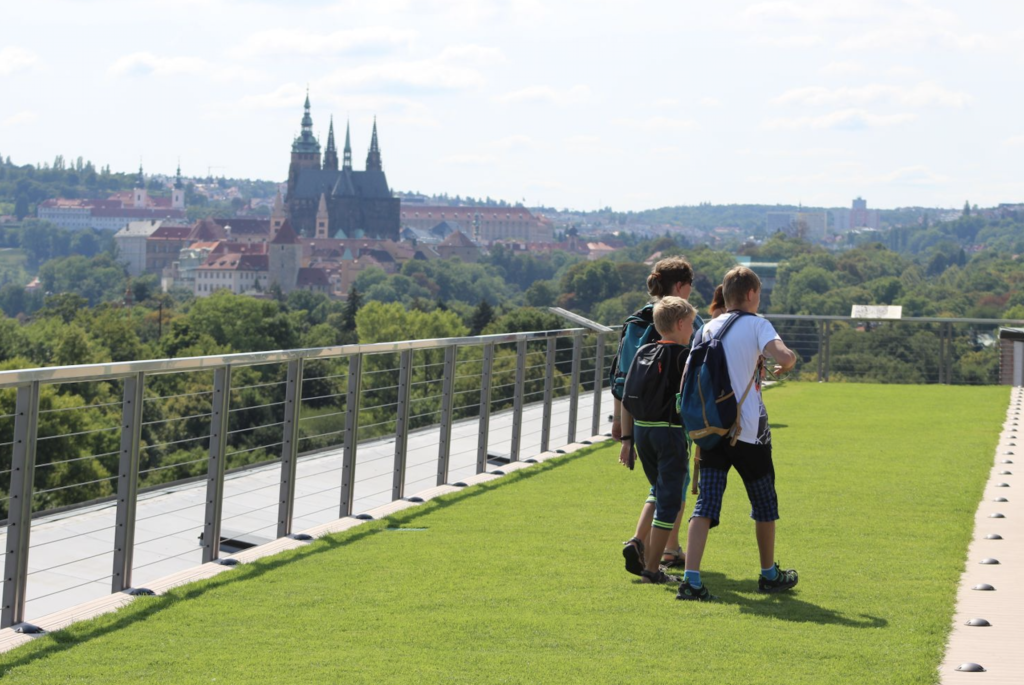
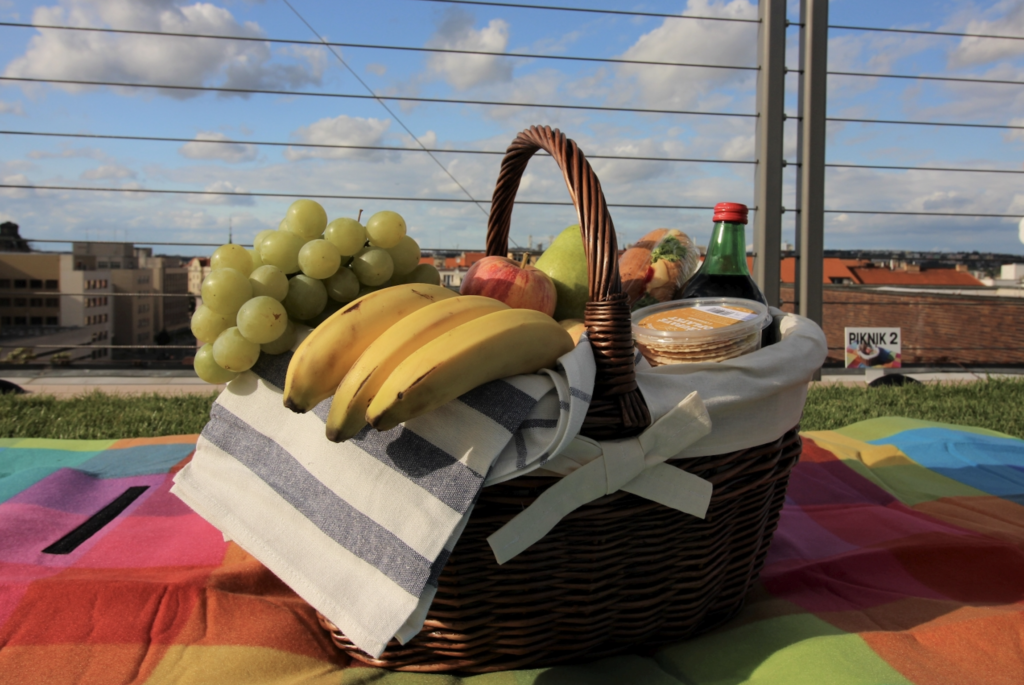
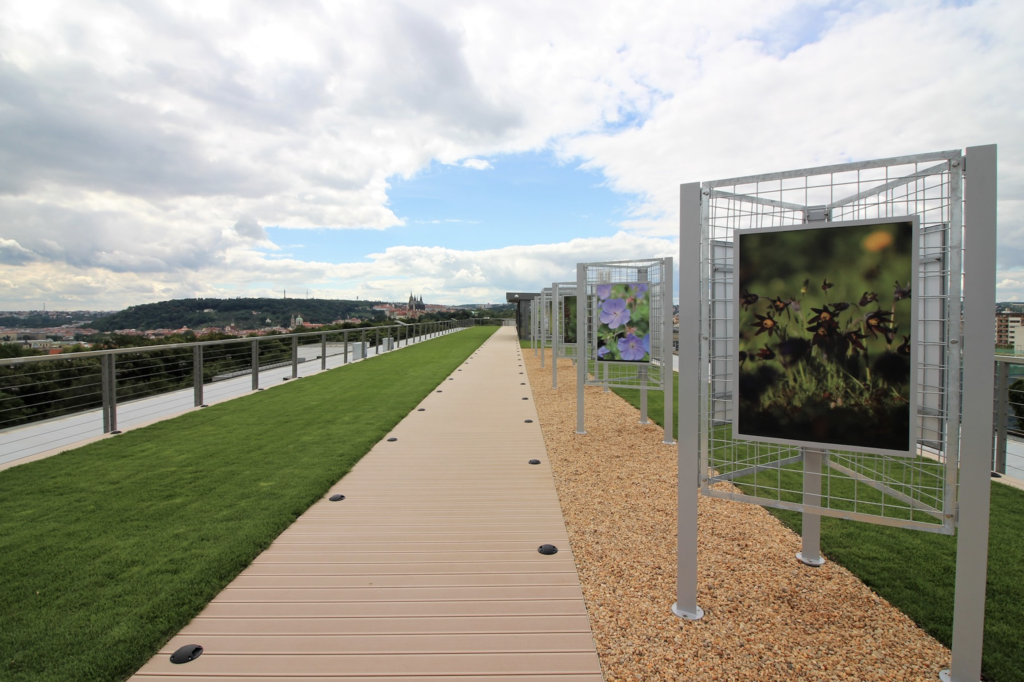
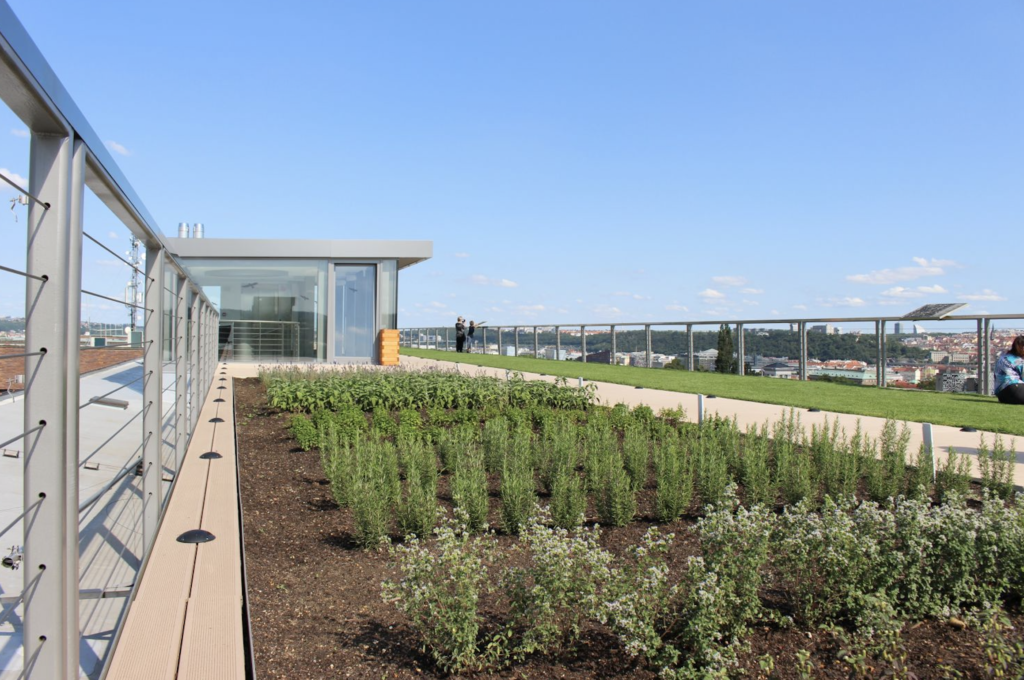
The Lucerna Palace (Palác Lucerna) is a huge building in central Prague, housing small shops, cafes, a music bar, a concert hall, and a cinema. There is also a paternoster lift that takes you to an amazing rooftop terrace.
The roof is open until the end of October 2020, Saturday to Monday 14.00 to 22.00 and entry is 100 Kč. If you arrive between 14.00 and 16.00 you can have a free drink from the rooftop bar.
The entrance is opposite the Great Hall in the Lucerna passage. A really friendly girl sold us our tickets and a grumpy security guard showed us to the paternoster lift – a chain of open compartments that move slowly in a loop up and down inside a building without stopping.
These things both scare and excite me, as I think I’m going to misjudge the jump into the compartment and be chopped in half – I’m also not good with revolving doors! Hence, I couldn’t start my video until after I was safely aboard.
You’re supposed to jump out at the top floor, but I stayed in the compartment and let it take me over the top and back down again – no you aren’t turned upside down!
At the top, another really friendly girl checked our tickets and we were inside. We wandered around the various rooftop terraces. The space is huge and there is work in progress to expand the terraces. The views are amazing.
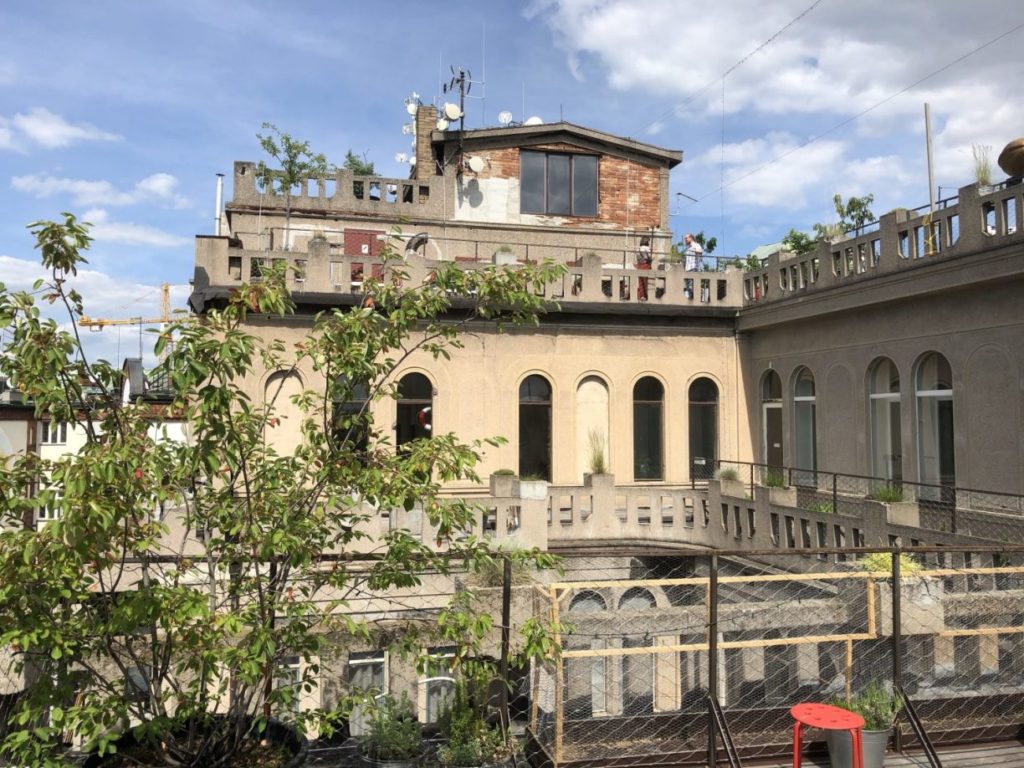
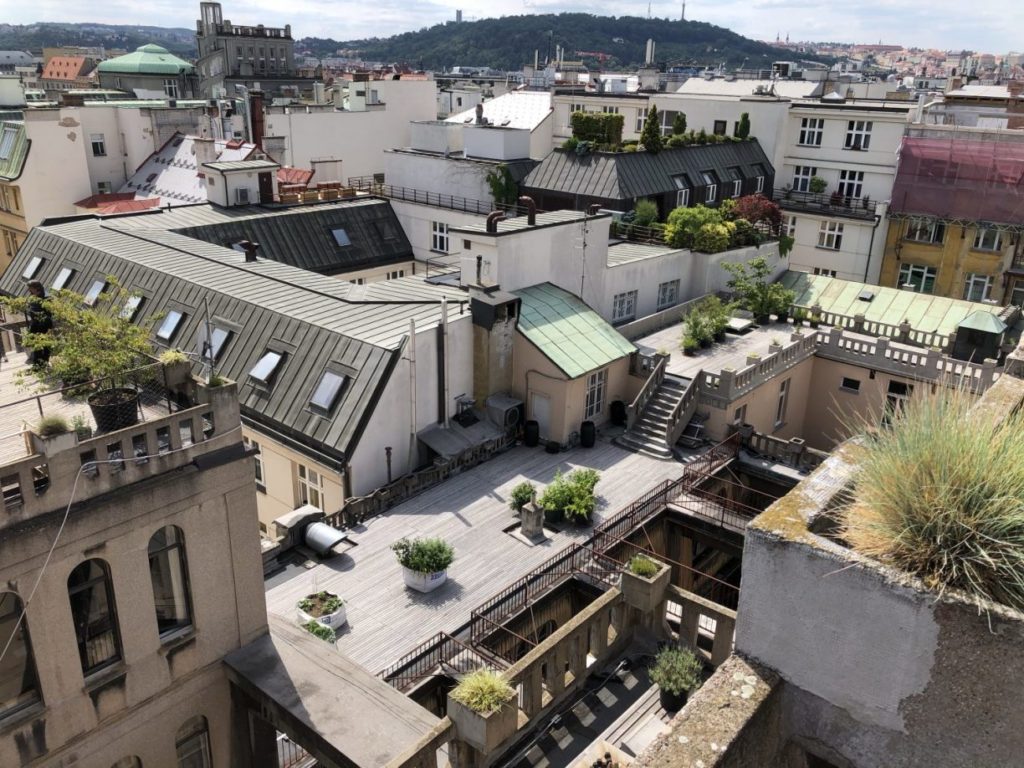
I’d previously written to Střecha Lucerny and asked some questions about the space – they didn’t reply. But I found one of the organizers and was able to ask him. My questions and his replies in between each of the following pictures.
Q. How do the rooftop concerts work – is there some program?
A. They are just short 15-minute concerts played at sunset. You can find out more from the Facebook page
Q. There are just a few tables – can I reserve one?
A. Yes, if you call ahead, we’ll do our best. There will be more tables when the reconstruction of the other terraces are complete.
Q. If I purchase a ticket and visit during the afternoon, can I return with that ticket in the evening?
A. No, you would need to purchase another ticket.
Q. Is food available?
A. Yes, some small bites, like tapas.
Q. What happens when it rains?
A. There is indoor space and we also have umbrellas that you can borrow.
Q. The website looks lovely, but doesn’t show any events or other information about visiting.
A. Yes, we know about that and we are working to resolve it.
We visited the bar. There were three staff working and they were really friendly.
Our first drink was free. The prices looked pretty good for the location; large beer 58 Kč, glass of wine 65 Kč, cappuccino 65 Kč. And we were given real glasses, not plastic cups.
There is an exhibition devoted to the history of the Havel family. The text is in Czech. My basic knowledge is that the palace was built between 1907-1920. The investor, organizer, and constructor was ing. Vácslav Havel, entrepreneur, whose grandson – Václav Havel – later became President.
Everyone working at Střecha Lucerny is friendly. It reminds me of when you visit a stately home run by amateur volunteers – all happy to chat, take your ticket or sell you a piece of homemade cake. It’s a nice atmosphere, but as a business, it’s ridiculously overstaffed and I have no idea how they can make any money – but maybe that isn’t their intention.
Střecha Lucerny
Palác Lucerna, Štěpánská 61, Praha
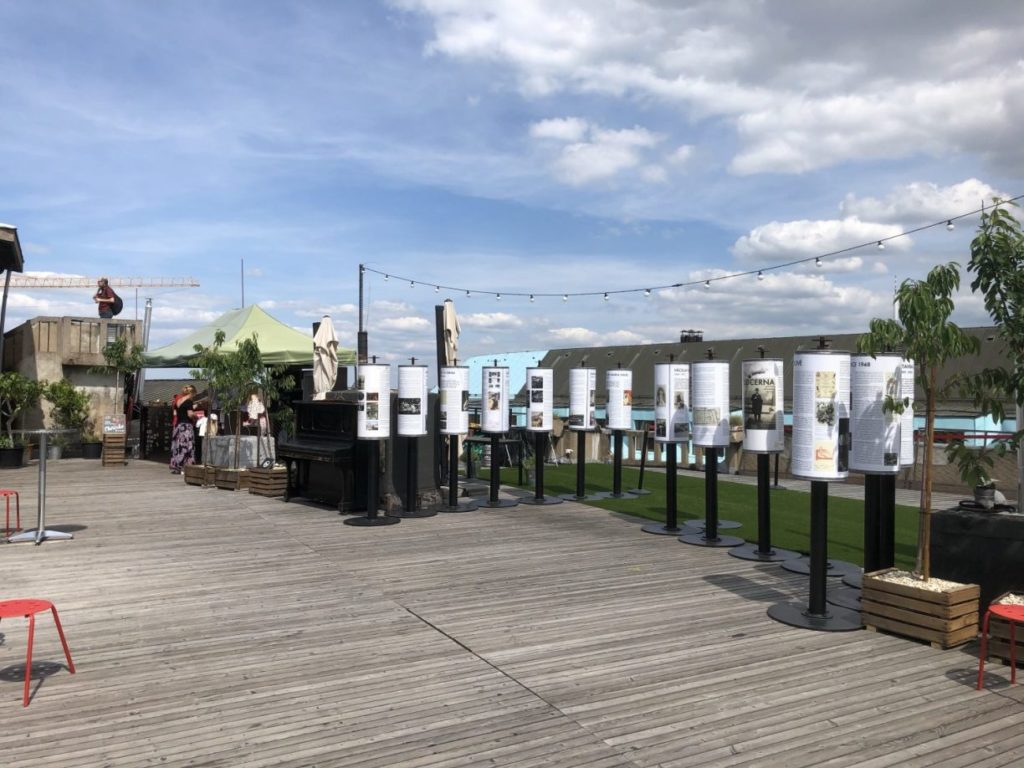
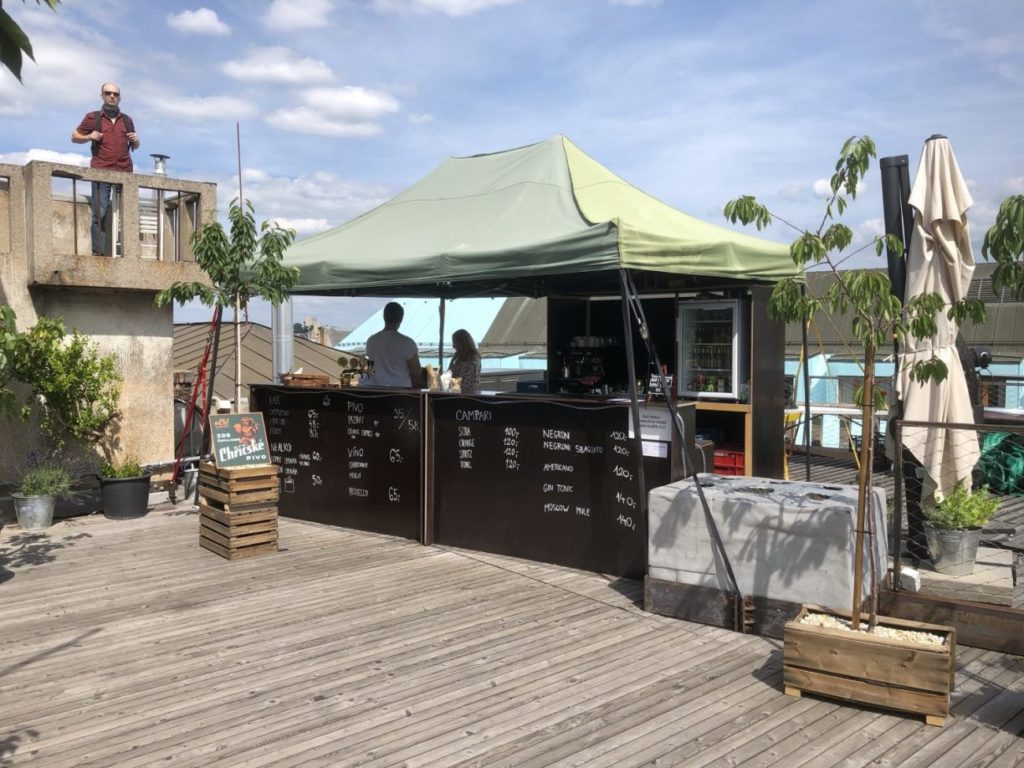
To prevent the spread of the COVID-19 pandemic, countries around the world have taken a variety of restrictive measures.
First 2020 numbers already show their significant impact on air transport for all 13 EU Member States according to an analysis conducted by the European Statistical Office (Eurostat): Czech Republic, Denmark, Germany, Croatia, Italy (see country note), Cyprus, Lithuania, Luxembourg, Hungary, Malta, Slovenia, Slovakia, and Finland.
Prague Airport is one of the most negatively affected airports in Europe: the number of passengers fell by more than 800,000, amounting to a drop of 65 percent year-on-year.
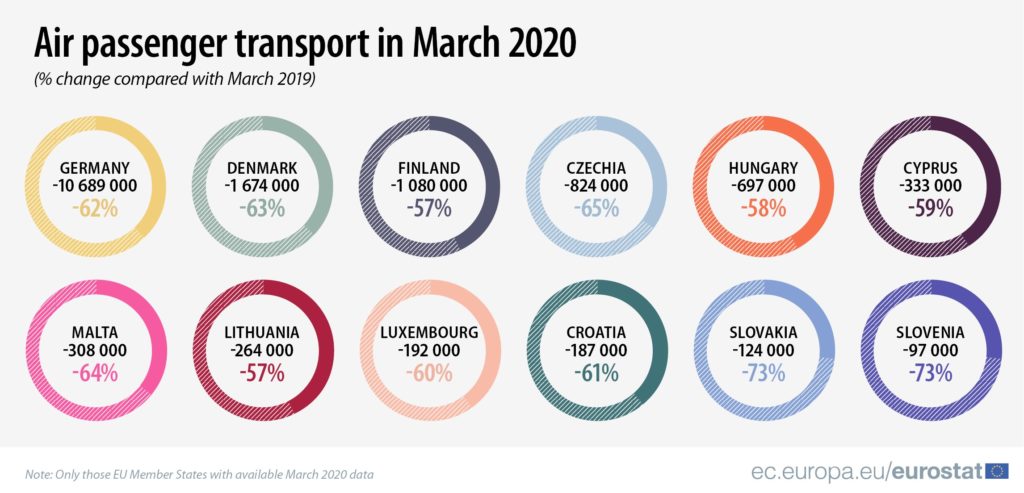
Prague Airport, together with Berlin’s Tegel and Schönefeld airports and Munich Airport, showed the largest percentage decrease when it comes to passengers handled. All four hubs had about 65 percent fewer travelers in March.
However, when considering absolute numbers, the number of passengers fell the most in Frankfurt by a total of 3.5 million.
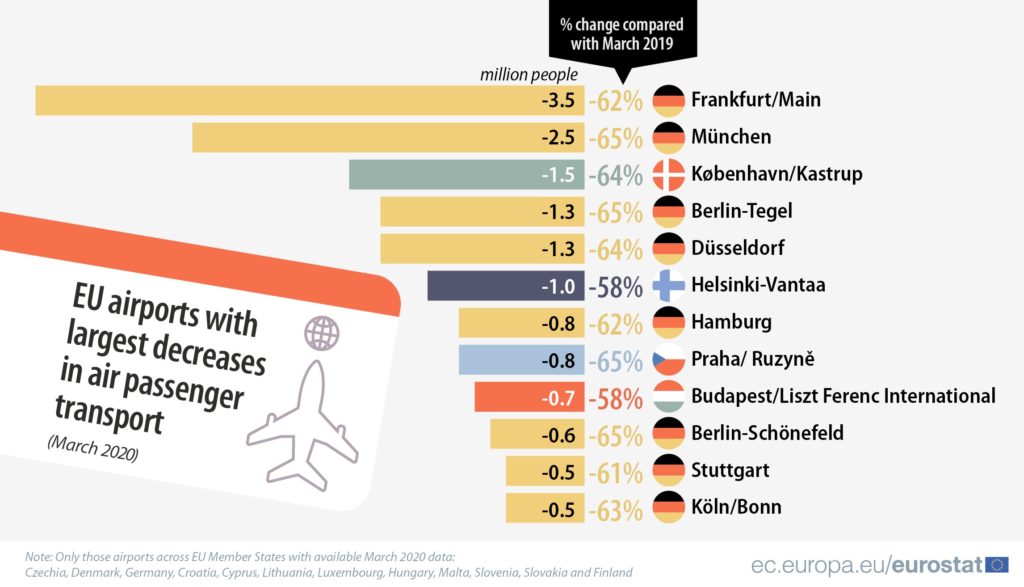
“None of the dozen EU airports shows a deeper percentage drop in the numbers of checked-in passengers than Prague’s airport,” said economist Lukáš Kovanda from the Czech Fund.
He also added that in January and February of this year, the number of passengers handled at Prague Airport was higher year-on-year, exceeding the value of one million in both months.
Whilst the number of air passengers in some of these EU Member States started to decrease already in February 2020, the number of passengers at least halved in all of them in March 2020.
Compared with March 2019, the largest decreases in numbers of passengers were observed in Italy (-85%, -11.9 million (see country note)), Germany (- 10.7 million passengers carried, -62%), Denmark (-1.7 million, -63%), Finland (-1.1 million, -57%), Czechia (-0.8 million, -65%) and Hungary (-0.7 million,

